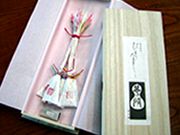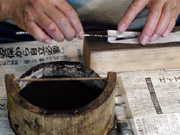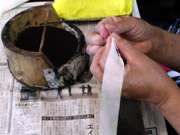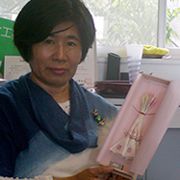The
ultimate sparklers"Hikari Nadeshiko" (Fire Pinks) made
by a female pyrotechnist
The
sparkling firework was named Nadeshiko Pinks (a variety of dianthus),
because of the way the firework sparks and looks just like the delicate
Pinks’ flower petals. This ultimate sparkler was made after
many years of labor and study by a female pyrotechnist. She devoted
every little moment to her research reading through volumes of scientific
books and documents.
On the bamboo bench is the ceramic pig-shaped vessel that contains
the mosquito repellant coils.The children dressed in starchy yukata,
after a bath washing off all the dirt and sweat from the hot summer
day's adventure, gather excitedly around in a circle in the garden.
The toy fireworks’ luminous bright sparks light up the happy
faces for a few seconds. The nezumi hanabi (mouse tail fireworks)
spins around wildly scaring the children as they shriek and giggle.
To end the evening are the sparklers. As the orange fireball fizzles
out and falls to the ground, everyone gives out a sigh. It is a
sigh of disappointment "Oh!...it's finished", and also a sigh of
content for the few moments of tranquility the firework brought
within oneself. Today, we see many generations living separately,
but in the past this was a typical summer scene with three generations
gathering together to enjoy the evening. I think for many Japanese
people, there is something special and nostalgic to the faint fragrance
of the pine smoke dust, that stirs up memories of such familiar
scenes of a summer night. In Feature 005, we will introduce a toy
firework for adults to enjoy and a story of the female pyrotechnist
who through determination discovered the means to make the ultimate
sparklers Hikari Nadeshiko.
|
Scrupulous
decisions and painstaking subtleties--making a little magic.
Kimiko Saito often heard people say " the
sparkling fireworks aren't as beautiful as it was in the past...",
and this led her to dedicate herself in her research. It has
taken her actually almost 30 years, to develop a firework
she was satisfied with. This is great news for those that
are not satisfied with the many toy fireworks imported from
abroad, that often lacks that “special-sparkle-something”.
They may look like simple sparklers, but there seems to be
something profound to it. What exactly was so special with
the "sparklers made in the olden times"?
I visited her studio, and Saito shared with me a little of
her secret on what she discovered through her research.
|
 |

|
|
The
initial step is making the perfect raw material, the pine
smoke powder, she explains. She says she finds red pine, 60
years old are most suitable. She took a piece of red pine
and lit it in front of me. The pine quickly caught fire and
formed a flame, giving off heavy black smoke. This smoke dust
collected becomes pine smoke powder. The quality of the smoke
dust and also the quantity of the smoke dust collected determine
the high performance of the powder. The proportion utilized
must be exact. Not too much or too little. She finds that
0.08 gram works the best. Next, assembling the right amount
of potassium nitrate and sulfur to the smoke dust is important.
This seems to be a secret she can not reveal. The type of
koyori paper used to wrap the raw materials plays a critical
role as well. It is the fibers of the paper that keeps the
fireball from falling. Without the right paper fiber, the
fireball will drop in an instant or remain glowing for too
long. "It will last as long as it should last, and it will
fall when it should fall." (It sounds like a Zen philosophy
and quest for an answer.)
|
 |

|
|
The winter
fireworks enjoyed by the men of refined taste in the Edo period.
There are probably many people who do not
know what a koyori is. They are very thin washi paper cut
into thin strips. Using both thumbs and index fingers, starting
from the tip of the paper, the washi is twisted to the very
end. The twisted washi becomes sturdy and stiff, and will
stand straight even when held up right. The raw material for
the sparks is wrapped in the bottom 3 cm. Saito is also very
particular about the type of washi she uses. She uses vegetable
dies, such as susuki (pampas grass), kihada (phellodedron
amurense), benibana (safflower) to color her washi. The "Hikari
Nadeshiko" made with all her affection and tender care, is
dressed in boxes made of paulownia wood. A piece of bamboo
charcoal is placed together in the box to protect from humidity.
She comments the colors of the spark become much more brilliant
when it is left to dry for sometime. In the Edo period, in
the fall and winter season, people enjoyed dry sparklers,
over the charcoal brazier placed in the room with a floor
made of packed earth. In the present time, it will be like
playing with fireworks on the balcony of an apartment.
|
 |


|
|
The
10 seconds of immense happiness
This 100% Japanese sparkling fireworks,
has been measured by the Toy Firework Inspection, to have
its sparks to reach a 30 cm diameter. This is the largest
diameter record that any sparkler has ever made. The sizzling,
fizzing sounds and the small Hikari Nadeshiko's sparks, brings
a smile to everyone for a few seconds. The fireball at the
end, begins to shake, as if refusing to fizzle out......fizzzzzz,
sizzle...... fizzzzz, the delicate sparks continue to glitter
in all direction in the darkness. The next second, it falls
to the ground. The very moments the fireball fizzles out and
falls, there is a feeling of emptiness. At the same time,
there is something soothing watching the very impressive and
beautiful performances of the dancing sparkles. One strand
of Hikari Nadeshiko is just 100 Yen (80 cents US). It is up
to the individuals to judge whether it is expensive or not.
I felt there was something much more special than the few
moments enjoying a delicious cup of coffee. The three strands
of sparklers I watched glitter away, brought me few minutes
of happiness. The feeling of great pleasure grows on you,
from somewhere deep down in your heart. There is definitely
a healing power to these sparklers. (Yuko Yokoyama)
|
 |

|
QuickTime (953 KB)
|
